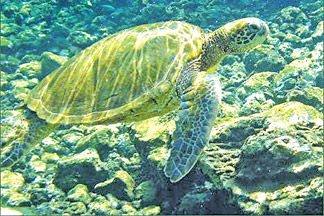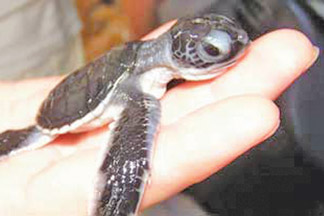|
Yesterday was World Turtle Day :
Hatching a plot to save turtles
Charmaine FERNANDO
|

Olive Ridley Turtle
|
Under the cloak of nightfall, dozens of freshly hatched sea turtles
beat their tiny flippers against the wet sands of our beaches, inching
their way toward the ocean and a life aquatic. It is the first of many
challenges these turtles will face in a lifetime that can exceed that of
the average human. But even those hatchlings that reach the water are
not out of the woods. As soon as they reach the sea hatchlings swim
constantly for about 48 hours.
During this time they do not feed. Instead they rely on the remains
of the egg yolk in their stomachs for nutrition. This is known as the
‘juvenile frenzy’ and is an essential behaviour which allows the
hatchlings to escape the predator-rich inshore waters as they are
carried away by the open ocean currents. Yesterday was World Turtle Day
and what better time to reflect on these harmless and gentle creatures.
Studies have established that when the female turtles reach maturity
they will return to nest on the same beach where they themselves
hatched. Here they lay eggs of their own, in dozens of nests that each
typically contain more than 50 eggs. It has been estimated that under
natural conditions only one in a thousand eggs survive to eventually
become mature adult turtles.
Under threat

A Green turtle depositing eggs. Picture by Thushan Kapurusinghe, Turtle
Conservation Project |

Green Turtle |

A hatchling |

A Leatherback turtle in Kosgoda. Leatherback turtle is the
largest of all sea turtles and critically endangered species.
Picture by Thushan Kapurusinghe |
The sea turtles’ way of life here is under increasing threat because
of the over exploitation of marine and coastal resources in Sri Lanka.
In addition turtle nesting beaches or rookeries are being disturbed by
tourist industry development and feeding habitats such as coral reefs,
sea grass beds being destroyed by pollution and unsustainable
harvesting.
Many turtles are accidentally caught and drowned in fishing gear each
year while the critically endangered species such as the hawksbill has
been hunted to the brink of extinction for its shell. In addition,
dozens of mature turtles are killed every breeding season, even before
reaching the shore, by boat propellers, dynamiting or by poachers hoping
to make a profit from the illegal sale of turtle meat.
Conservationists have been fighting to put a stop to deadly
industrial fisheries and increase protection. They do their best to
protect turtle nests by roping them off and posting signs warning that
it is a felony to disturb the eggs of these creatures threatened with
extinction, but it is sometimes not enough. Egg poachers and vandals
have destroyed a number of nests in recent years along stretches of the
island’s traditional nesting grounds.
The Green turtle (Chelonia mydas) Leatherback turtle (Dermochelys
coriacea) Olive Ridley turtle (Lepidochelys olivacea) Loggerhead turtle
(Caretta caretta) and the Hawksbill turtle (Eretmochelys imbricata) are
among the different types of turtle who come ashore to nest on our
beaches.
All five species are listed by the World Conservation Union (IUCN) as
either critically endangered or endangered. Despite this international
legislation and the local protection provided by government legislation
since 1972 marine turtles are still being extensively exploited in Sri
Lanka for their eggs and meat.
Ultimate destination
All these species are known to nest in the Kosgoda area on the south
of the island. The four kilometre stretch of beach situated from the
northern end of Kosgoda lagoon to the rocky outcrop south of the Victor
Haselblad hatchery has been identified as the best turtle beach in the
area.
Surveys carried out by both the Turtle Conservation Project (TCP) and
the National Aquatic Resources Research and Development Agency (NARA)
indicate that almost all of the sea turtle nests occurring on Kosgoda
beach are plundered for their eggs.
The eggs are sold to private dealers for distribution and consumption
or sold to turtle hatcheries.
Hatcheries in the Kosgoda area pose a dual threat to sea turtle
conservation. Their methods have yet to be proven as successful but
their proliferation gives the impression that “something is being done”.
Wildlife Department Assistant Director Upali Padmasiri says said that
under the Flora and Fauna Protection (Amendment) Act, No 22 of 2009,
turtles are a strictly protected species and thus, they cannot be sold,
captured, caged or bred.
According to the amendment any persons found guilty of any of these
offences are liable to a fine of not less than Rs 10 000 (approximately
US $200) and or a prison term of not less than two years.
Hatcheries harmful?
He said that although it looked as if the turtles were being
conserved by the hatcheries, the practice could be ecologically harmful
as it may change the gender balance of the turtles. “If the eggs are
protected where they are laid, it is fine. But when the eggs are taken
away and hatched in another place, the temperature under which the
hatching takes place differs, which in turn determines the gender. Thus
the gender balance of the turtles is affected,” he warned.
Elaborating on the negative aspects of the turtle hatcheries, Upali
Padmasiri said, when the turtles hatch in their natural habitat, they
head for the sea and swim for 48 hours non-stop, passing areas where
most of their predators are.
“But when they are hatched in simulated environments, they are put
into tanks in which they swim for 48 hours they are exhausted and become
easy prey for predators, he said.
“Even with conservation, less than one percent of the turtles
released into the sea get an opportunity to grow into adulthood,” he
said. But for the sea turtles’ advocates, protection starting at birth
is the key to their future survival.
Conservation
Meanwhile, Kosgoda Sea Turtle Conservation Project Manager Dudley
Perera said although the state did not have legal provisions to grant
permission to maintain turtle hatcheries, there were about 10 hatcheries
in existence, some of which were about 25 years old. “What we do is
preserve the eggs that would otherwise have been sold in the market. And
we are doing this without government or NGO assistance,” he explained.
Kosgoda Police insists this area was famous for its turtle hatcheries
and though the police fine those caught stealing turtle eggs from the
beach the killing of turtles is less now due to the hatcheries. Taking
these facts into consideration the Turtle Conservation Project (TCP) has
initiated a community based nest protection programme with a grant
received from UNDP.
The main goals of this new initiative are to protect all sea turtle
nests laid within the project boundary to provide direct and indirect
alternatives to those who were previously dependent on egg poaching to
train locals in income generation and to promote eco-sensitive nature
tourism and to foster education and awareness.
TCP currently employs 15 community members from Kosgoda as ‘nest
protectors’ who were previously dependent on sea turtle egg gathering.
The initiative includes a training component to train locals as tourist
guides and to provide them a government-certified tourist guide license.
In addition batik and coir production as well as an education and
awareness programme on sea turtles among the school children and fishing
community in Kosgoda are taking place. The project receives considerable
support from local state institutions such as divisional secretariat and
the Sri Lanka Tourist Board for its successful implementation.
Yet one thing that would be a comforting thought to conservationists
and a positive promise to ensure the sea turtles’ survival for posterity
is certain: Whether they are cavorting among coral reefs or sunning on
the beach, it is a reassuring reflection that the turtles have many
caring individuals and agencies looking out for them. |



